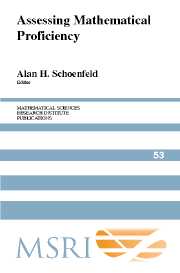Book contents
- Frontmatter
- Contents
- Preface
- Acknowledgments
- Section 1 The Big Picture
- 1 Issues and Tensions in the Assessment of Mathematical Proficiency
- 2 Aims of Mathematics Education
- 3 The No Child Left Behind Act: Political Context and National Goals
- Section 2 Perspectives on Mathematical Proficiency
- Section 3 What Does Assessment Assess? Issues and Examples
- Section 4 The Case of Algebra
- Section 5 What Do Assessments Assess? The Case of Fractions
- Section 6 The Importance of Societal Context
- Epilogue: What Do We Need to Know? Items for a Research Agenda
- About the Authors
- Subject Index
- Author Index
- Task Index
2 - Aims of Mathematics Education
Published online by Cambridge University Press: 06 July 2010
- Frontmatter
- Contents
- Preface
- Acknowledgments
- Section 1 The Big Picture
- 1 Issues and Tensions in the Assessment of Mathematical Proficiency
- 2 Aims of Mathematics Education
- 3 The No Child Left Behind Act: Political Context and National Goals
- Section 2 Perspectives on Mathematical Proficiency
- Section 3 What Does Assessment Assess? Issues and Examples
- Section 4 The Case of Algebra
- Section 5 What Do Assessments Assess? The Case of Fractions
- Section 6 The Importance of Societal Context
- Epilogue: What Do We Need to Know? Items for a Research Agenda
- About the Authors
- Subject Index
- Author Index
- Task Index
Summary
Education is our means to instruct our youth in the values and accomplishments of our civilization and to prepare them for adult life. For centuries, arguments have been made about what an education means and how to distinguish an educated person from an uneducated one. Two views have contended for our allegiance since the time of the ancient Greeks [Marrou 1956]. One perspective is the rational and humane vision of the Sophists and later the philosopherteacher Isocrates, for whom the test of an education was its ability to prepare a citizen to engage in public affairs. The other view is that of Plato and Socrates, who taught that education must guide the student toward an uncovering of the Truth and Beauty that underlie our human experience, the universal themes and natural laws that a well schooled mind can discern beneath the surface confusion of life and the awakening of the spirit within, that allow us to care intensely about life and learning.
We cannot clear up some of the controversies about mathematics education and how to assess learning until we deal with two underlying issues. The first is the mindset that underlies our approach to assessment. The other is to articulate and then discuss our often unspoken assumptions about what it means to be well educated.
- Type
- Chapter
- Information
- Assessing Mathematical Proficiency , pp. 17 - 22Publisher: Cambridge University PressPrint publication year: 2007



